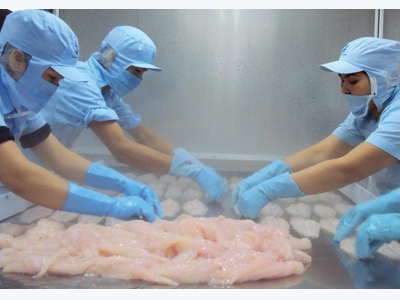Pangasius exports to China increase, but there are many concerns

While major import markets have signs of significant decline, in the first months of 2017, Vietnamese pangasius exporters are moving to Asian markets. Notably, exports to the China market continues to highly increase.
Pangasius processed for export
According to the Vietnam Association of Seafood Exporters and Producers (VASEP), in the first three months of 2017, total of pangasius export value reached $US 371.3 million, up by 1.6% over the same period last year. The export market structure clearly moved; exports to China continued to increase by 56.8%.
Specifically, in the first three months of 2017, the pangasius exports value to China reached $US 69.7 million, up 56.8% over the same period last year. Notably, from February 2017, China became the largest import market of Vietnam’s pangasius exporters.
Currently, there are nearly 40 Vietnamese enterprises exporting pangasius to China through Cat Lai Port, Bac Phong Sinh border gate (Mong Cai - Quang Ninh); Chi Ma border gate (Lang Son); Na Lan and Ta Lung border gate (Cao Bang). It is said that in early this year, China continues to be the destination and potential market of the Vietnam’s pangasius exporters.
In the recent10 years, demand for seafood imports of China has sharply increased, in which, shrimp and pangasius are the two products with the highest import value from Vietnam. However, in recent years, the import growth of pangasius in this market has rapidly increased. Pangasius has gradually become a favorite food beside seafood and whitefish and can compete with Chinese tilapia. Only in 2 years (2015 - 2016), the pangasius export value to China export market increased nearly twice.
However, VASEP also noted that enterprises should be more careful when implementing non-commercial transaction with this market. Because, as reflected by some Pangasius exporters, pangasius exports to China market is very potential and have many opportunities. Some time, the export price of pangasius to China was higher than that to EU market. But Chinese importers were willing to accept the price increase because in fact they can sell the Pangasius in their country at a much higher price than the purchase price from Vietnam.
However, many exporters said that selling the pangasius to some Chinese enterprises means accepting risks, including the risk of payment. Normally, many Chinese enterprises propose to deposit only 30% of the total amount of the pangasius shipment and plus the average transport price of a pangasius shipment to the border gate of about 45 - 47 million vnd. When the container arrive the border gate, Chinese importers receive goods, that means the transaction is successful, but otherwise, it is considered as a loss.
Currently, most of pangasius products are exported to China market in 2 main types: pangasius butterfly and pangasius fillet. Some Vietnamese enterprises said that it will be great if the Chinese importers agree to buy pangasius butterfly because they normally pay a good price and import large volume but if they do not buy, it will be difficult to export to any market.
Payments for the pangasius exports shipments to China are quite diversified, the importers can pay in USD, RMB or even VND. However, most of the importers require to pay in Yuan or VND. Of course, most Vietnamese exporters expect the importers pay in USD but many Chinese enterprises only pay in Yuan as domestic consumption.
Currently, some foreign enterprises are hiring factories or processing the pangasius products in Vietnam and then transporting them by road to China for consumption through unregulated trade without being controlled. This may affect the quality of seafood exports and be unfair to exporters.
In the first three months of 2017, the export value of the five largest pangasius exporters in Vietnam, which were Vinh Hoan Corp, Bien Dong Seafood, Navico, Hung Vuong Corp and IDI Corp reached $US 140.4 million, accounting for 37.8% of total pangasius exports of the country equivalent to the same period last year. The export market structure of these large exporters also clearly moved to the Asian market, including China and Latin America. Thus, if the problem of shortages of breeder and raw material in the Mekong Delta is resolved in the early months of the year, it is forecasted that the pangasius exports will continue to increase by over 5% compared to 2016.
Related news
 Fishery output exceeds 1 million tonnes in four months
Fishery output exceeds 1 million tonnes in four months Vietnam’s fishery output in the first four months of this year exceeded 1 million tonnes, up 5.7 percent year-on-year thanks to favourable weather
 VN shrimp brand: difficult, but not too late
VN shrimp brand: difficult, but not too late Việt Nam is the third largest shrimp producer and the largest giant tiger prawn producer in the world. Shrimp is a major export item
 Mekong Delta farmers start first shrimp harvest season
Mekong Delta farmers start first shrimp harvest season Farmers in the Mekong Delta have started the first harvest season of brackish water shrimp, generating great profits due to high prices and good culture